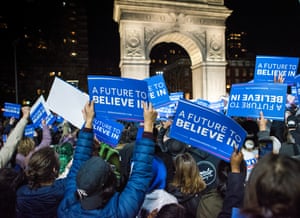But Sanders’ performance and prospects can’t be assessed by the metrics of traditional electoral politics, because he has always set the goals of his campaign on terms that defy the yardsticks of campaigning as we know it.
Despite the “Bernie” thing, Sanders presents his persona as no more than the sum of the
ideas and principles he puts before the electorate in pursuit of a “political revolution” against a political system in thrall to corporate cash. It’s a project he hopes will outlive his candidacy, and even his person. Like Stanley Kubrick’s Spartacus, he is inviting any citizen running in local, state or nationwide elections – or waging local-level citizen campaigns – to be Bernie Sanders.
That’s not a win-or-go-home presidential bid.
“A campaign has got to be much more than just getting votes and getting elected,” he told an interviewer soon after
launching his run. “It has to be helping to educate people, organize people. If we can do that, we can change the dynamic of politics for years and years to come.”
Sanders won’t be involved in politics for “years and years to come”, of course. Nor does he need to win the Democrats’ nomination to validate his campaign’s investment in political education and organization. A “political revolution” can’t be built in a single election cycle.
Sanders’ campaign looks more like an extension of the extra-electoral politics of phenomena like the Occupy, Black Lives Matter, Fight for $15 and Dreamer movements, small-d democratic citizen activism bypassing political institutions beholden to narrow, moneyed interests. Those movements are based outside the Democratic party – as was Sanders himself before he decided to seek its nomination – but through grassroots activism they have forced their issues on to the party’s agenda. Sanders has taken that same disruptive spirit into a national campaign to restore the Democrats’ New Deal values, and reverse their capitulation to the Republican fiscal agenda that began with the presidency of Bill Clinton.
He grounds his campaign in the time-honored tradition of America’s progress towards social justice – whether on race, women’s equality, labor rights and LGBT equality – being driven not by elected politicians, but by the willingness of ordinary women and men to take action that eventually compels political elites to respond. He’s not promising to solve problems himself, as much as to use the White House as a bully pulpit to mobilize citizens against the forces that keep the status quo intact.
“You have to develop grassroots organizations,” he told an interviewer questioning how he’d deliver with so little support for his positions on Capitol Hill. “You have to bring the grassroots in much closer to what’s happening in Congress.” Elsewhere, he noted: “We can elect the best person in the world to be president, but that person will get swallowed up unless there is an unprecedented level of activism at the grassroots level.”
Barack Obama also rode the crest of a mass movement seeking progressive change to win the nomination and the election in 2008. But he just as quickly demobilized it and governed as a centrist technocrat. In Sanders’ own telling, Obama’s biggest mistake was that “after his brilliant campaign in 2008, he basically said to the millions of people who supported him: ‘Thanks for getting me elected – I will take it from here.’ I will not make that mistake.”
A “movement” campaign for a “movement” presidency, then, in the tradition of America’s social justice history of which Sanders was a part, as a young activist against segregation and war.
These goals are generational, and achieving them isn’t dependent on winning the Democratic nomination. We won’t know whether the campaign succeeded or failed in this longer game for many years to come. But given its movement-building goals, we know that it will not necessarily have failed if he doesn’t secure the Democratic party nomination.
The scale of support Sanders drew in a hastily conceived presidential bid launched less than a year ago is evidence of wide and deep enthusiasm for his ideas, not his persona. It’s a relatively safe bet that the next time the Democratic party has to chose a nominee, that person’s ideas will be closer to Sanders’ than to Clinton’s.
The key, for Sanders, is his belief that the grassroots activism of his campaign has to continue after the election – whether or not it puts him in the White House. The metric of his campaign’s success is not simply whether voters in the primaries or in November “feel the Bern”. He has made clear all along that, win or lose, it’s the after-Bern that counts.


No comments:
Post a Comment